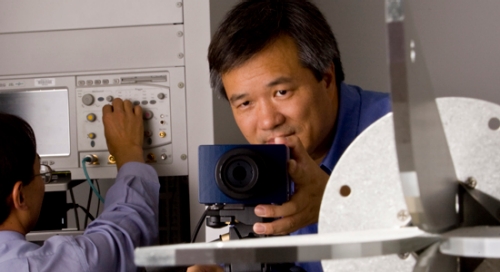CAC Awarded Air Force Contract for Next-Generation Over-the-Horizon Radar Development
Over-the-horizon radar (OTHR) systems have been critical to providing comprehensive wide-area surveillance for homeland defense for decades. As defense and military systems evolve, however, the need to improve existing OTHR capabilities grows in importance. The Center for Advanced Communications has received a two-year, $267,000 contract from the United States Air Force to develop “next generation” OTHR (NGOTHR) technology to mitigate radar clutter and to improve target geo-location accuracy.
“At the CAC, we’re very proud of our new relationship with the Air Force Research Lab at Wright Patterson in Ohio,” says Dr. Yimin Zhang, Director of the CAC’s Wireless and Communications and Positioning Laboratory and principal investigator for the contract. “We’re pleased to be selected for this collaboration, which will help address some important current OTHR challenges that will enable U.S. tactical forces to protect the United States’ shores and borders more effectively.” Dr. Moeness Amin, Director of the CAC, and Dr. Fauzia Ahmad, Director of the CAC’s Radar Imaging Lab, are co-PIs on the project.

Dr. Yimin Zhang, Director of the CAC’s Wireless and Communications and Positioning Laboratory Photo credit - Aurora Imaging Company
OTHR systems make use of the reflective and refractive nature of high-frequency (HF) radiowave propagation through the ionosphere to perform long-range surveillance well beyond the limit of horizon of conventional line-of-sight radars. While OTHR technology has been very effective in allowing persistent air and maritime surveillance, both inland and for thousands of miles off the U.S. coastline, there have been challenges associated with spread-Doppler clutter, which degrades system performance. In addition, accuracy in geo-locating the target, especially altitude, has been lacking. CAC researchers will address each challenge as part of the contract.
To improve the quality of signal returns, CAC researchers will leverage the advances in multiple-input multiple-output (MIMO) radar technology. MIMO systems, which use multiple antennas to simultaneously transmit diverse waveforms and utilize multiple antennas to receive the reflected signals, possess significant potential for clutter mitigation, resolution enhancement, and interference and jamming suppression. The team will focus on joint sparse array and waveform design techniques to enhance maneuvering target detection and tracking in the presence of strong clutter and multipath signal propagation.
CAC researchers will also develop novel time-frequency analysis techniques to improve position estimation of very distant maneuvering targets of hundreds and thousands of miles away, and in particular, their altitude information. Altitude can be indirectly provided from micro-multipath returns due to ground/sea reflections local to the target. New algorithms of high-resolution time-frequency signal representations of the micro-multipath returns will permit fast and robust altitude tracking.
For more information about the CAC, its resources, and facilities, visit the Center for Advanced Communications.
